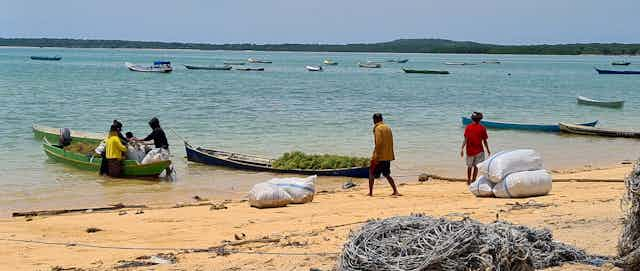Indonesia, the world’s second-largest seaweed producer, plans to introduce a nationwide export ban on seaweed, following a ban at a provincial level in 2022.
President Joko “Jokowi” Widodo argued in November that the ban would encourage investment in domestic seaweed processing, as part of a larger suite of export restrictions.
However, my research on seaweed value chains in Indonesia suggests that an export ban on Indonesian seaweed would adversely impact domestic seaweed production. Seaweed farming is Indonesia’s largest marine aquacultural activity, representing US$1.89 billion of the total $2.05 billion Indonesian marine aquaculture production annually. Over the last twenty years, it has grown rapidly and now supports the livelihoods of around 62,000 farmers, as well as many more people in coastal communities who work as casual wage labourers in the industry.
An export ban is likely to lead to lower commodity prices, turning some of those farmers to other sources of income and reducing national production. It also would not ultimately support domestic processors to compete with large foreign companies operating in Indonesia to access seaweed supplies.

The threat to prices and production
Over the last decade, the Indonesian government has considered export bans to prevent the sale of unprocessed seaweed to the global market. So far, these policies have yet to be implemented nationally.
However, Nusa Tenggara Timur implemented a provincial ban on seaweed exports in 2022.
Governments usually introduce export bans to support domestic value-adding by protecting industries from international competition.
Just one-third of Indonesia’s seaweed production is processed domestically, with the remainder being shipped internationally.
My collaborative multidisciplinary research on seaweed value chains since 2020 has explored how international and national industry and policy dynamics affect farmer livelihoods. The research involved a detailed examination of seaweed value chains in Indonesia to understand what global and regional factors influence pricing and farmer livelihoods.
When export restrictions are introduced, farmers can no longer sell to international buyers at the world market price. Instead, they must sell at the price set by domestic demand.
With fewer buyers competing for products, Indonesian seaweed prices would immediately reduce from the higher world price (shown as 1 in the diagram below) to the price set by local Indonesian demand (shown by 2).

As seaweed farmers are very responsive to changes in prices, they can easily choose not to grow any more seaweed if prices are low. This means that when prices drop, production drops too, since farmers aren’t motivated to produce as much seaweed.
They can take their profits from seaweed and invest them in other activities, such as marine fishing or farming of shrimp and fish in ponds. They may produce seaweed only in more favourable areas and seasons, and are less likely to persist when yields are low.
If that happens, over time seaweed production would decrease, competition for seaweed would increase, and prices would rise again – but not to the same level as before the ban.
The effects of this are shown below: prices would at first drop significantly, then rise again as production falls. Price and production would then stabilise at lower levels.

As a result, an export ban is likely to lower the prices seaweed farmers receive, as well as shrink Indonesia’s total seaweed production.
Read more: Indonesia is the world’s largest seaweed producer but why are prices so volatile?
Competition from within Indonesia
The export ban is proposed to support domestic value-adding by reducing competition for raw materials. However, ultimately, Indonesian seaweed processors will still have to compete with large, foreign-owned companies based in Indonesia.
Seaweed processing in Indonesia is dominated by large, Chinese-owned companies, which have many staff and high costs.
Foreign-owned companies control around half of all seaweed processing in Indonesia. These companies are, on average, four times larger than domestic companies. They cannot easily stop production, so they will try to keep buying seaweed as supply drops, and usually will be willing to pay more than smaller, local companies.

These factors suggest that a ban on raw seaweed exports may not help domestic processors to compete with foreign-owned businesses. Any companies pursuing alternative uses for seaweed – such as bioethanol, biostimulants or bioplastics – would also need to compete with these large Chinese-owned processors.

Alternative ways to grow seaweed production
Instead of implementing restrictive agricultural trade policies, the Indonesian government could consider other ways of encouraging the sector’s growth – such as by helping farmers become more productive and sustainable.
For instance, the government can support domestic processors in upgrading to more efficient processing technologies. They can also invest in research and development in the sector.
The Indonesian government already does this in several ways: for example, by supporting research into alternative products from seaweed, like bioethanol.
However, many of these technologies are currently still too expensive to be implemented. To make bioethanol, it is necessary to break down the tough cell wall of seaweed. This is energy-intensive and often expensive. This means that it is cheaper to produce bioethanol from products other than seaweed.
Developing economically viable alternative products from seaweed will need sustained investment in improving processing economics, not short-term market intervention.

There are other ways to support the growth and efficiency of the seaweed industry. For example, implementing a national system for satellite monitoring of marine aquaculture could help us understand how farmers respond to long-term and seasonal changes to better support farmer production and resilience to climate change.
Digital technologies may provide opportunities to improve the productivity and resilience of smallholder seaweed farming, but need to be designed to benefit seaweed farmers and coastal communities.

Seaweed farming plays an important role in supporting coastal community livelihood and adaptation to climate change, as well as in the Indonesian government’s rural development and blue economy initiatives.
Maintaining sustainable growth of the Indonesian seaweed industry will require a nuanced understanding of seaweed supply and demand, farmer livelihoods, farmer technology uptake, as well as the global market. This is not a short path, but a more sustainable one in the long term.


